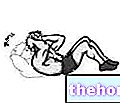Analyzing - objectively - the various "metabolic situations" necessary to induce the mechanisms of muscle growth, we come across a clear contradiction: the diffusion of training techniques is not directly proportional to their effectiveness.

One of these undeservedly "extinct" techniques is that of cumulative repetitions.
Cumulative repetitions - in a sense - are based on the same principle as Rest-Pause and one of the possible ways (perhaps the classic one) of applying this technique is the following:
- load the tool with 75% of the maximum (in practice it is the load that, pulling to the limit, should allow us to perform 8-9 repetitions)
- perform a single repetition with this load and rest for about 10 seconds;
- always perform two repetitions with the same load and rest for about 10 seconds;
- always perform three repetitions with the same load and rest for about 10 seconds;
- always perform four repetitions with the same load and rest for about 10 seconds;
- and so on.
In practice, it is necessary to continue increasing the repetitions to be performed by one unit each time and the series ends (remember this point, however, because in a few lines I will indicate how to go even further) when this is no longer possible.
If, for example, we manage to successfully perform 6 cycles and fail the seventh cycle where we were able to complete only 4 repetitions (and not the 7 planned), in the end - thanks to the 10-second rest intervals - we will have done well 25 reps with a weight that, in a traditional set, would have allowed us no more than 9 reps.
But what is the point of all this?
Well, apparently, one of the most appropriate ways to increase muscle size is to exhaust the phosphate pool and to do so mainly in the white fibers, which are the most easily hypertrophied.
To do this it is necessary to use a consistent load (65-85% of the maximum) and at the same time perform a good number of repetitions (about 12-15).
All this, with the series performed in the traditional way, is not very simple (if not impossible) to obtain, as the accumulation of lactic acid would cause the block of muscle contraction before inducing the cellular exhaustion mentioned above [ see diagram].

The intensity of the technique is really remarkable, so my advice is not to overdo this type of "extended series": I think that only one series is ideal and that, in any case, it is better not to go beyond two.
An interesting discourse to analyze is that relating to the exercises to choose. The first rule is always to move towards the "basic" exercises, but sometimes, especially when we come across such intense techniques, it may happen that the muscles that yield first are the support ones and not (thus making the training fruitless) those that we want to train. An immediate solution could be to resort to isolation exercises, which however often have the limit of not allowing the use of large loads.
One way to effectively apply the technique of cumulative repetitions even to the "basic" exercises may be to perform what I define "technique of cumulative repetitions with alternating exercises", which consists of" alternating between a basic exercise and an isolation exercise within the same series. To better explain the concept, here is a practical example for chest training (load both tools with 75% of the maximum) :
- Bench press → 1 repetition and 10 second rest
- Bench press crosses → 2 reps and 10 second rest
- Bench press → 3 reps and 10 second rest
- Bench press crosses → 4 reps and 10 second rest
- Bench press → 5 reps and 10 second rest
- Bench press crosses → 6 reps and 10 seconds rest
And so on until we manage to increase the repetitions from the immediately preceding sequence.
The final touch
It should be emphasized, however, that the production of lactic acid is to be avoided at the beginning and during the series, but it is to be sought at the end, as it can stimulate the endogenous secretion of GH. To do this, we can add 1-2 series in Stripping to the final mini-sequence (the one we couldn't complete).
But be careful:
- Have the good sense to adopt this final "coup de grace" only in the last series (if you perform two) of cumulative repetitions
- The "coup de grace" cannot be used - with compound exercises - if after you have to train another "muscle section synergistic to the exercise" you are performing: for example if you are training the pectorals and immediately afterwards you intend to train the triceps; in this case, to get around the problem, you can perform the "coup de grace" with an isolation exercise. In other words, referring to the previous scheme of "cumulative repetitions with alternating exercises", you can add the two sets in Stripping by adopting the" crosses on the bench "exercise and not the" bench press "exercise.
- Do this procedure only after you have become an "expert" in cumulative repetitions.
Details on rest breaks and loads on tools:
- in the examples I have indicated 10 seconds for the rest between the repetition sequences, but obviously it is not "written law" on the rock. Especially in large muscle groups it is not a bad idea to try to increase this rest pause a little (even up to 20-25 seconds).
- in the examples I have indicated 75% of the ceiling, but obviously this too is not "mandatory". The useful range goes, approximately, from 65 to 85%, so try from time to time to vary the percentage of the ceiling to find the one that best suits your characteristics.
BIBLIOGRAPHY:
Renato Manno: "Physiology of sports training", Zanichelli, Bologna, 1989
Angelo Day: "Body-Building DuemilaUno", TRAM srl, Florence, 2000

<Francesco Currò
Francesco Currò, ASI / CONI teacher, teacher of the "Academy of Fitness, athletic trainer and personal trainer, is the author of the new book"Full Body", of the" e-book "The Training"and the book on" Multiple Frequency Systems ". For more information you can write to the email address [email protected], visit the websites http://web.infinito.it/utenti/x/x_shadow/
or http://digilander.libero.it/francescocurro/
or call the following number: 349 / 23.333.23.




























